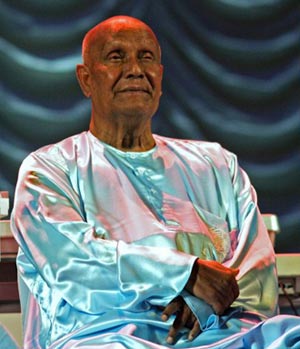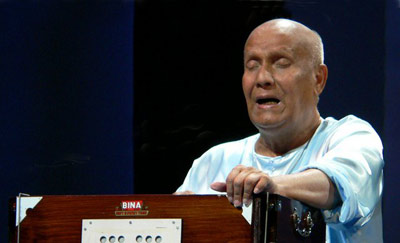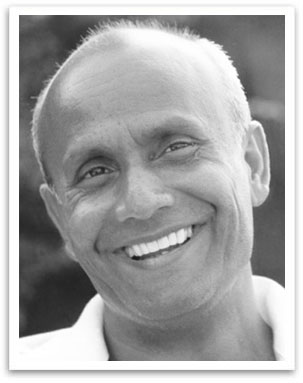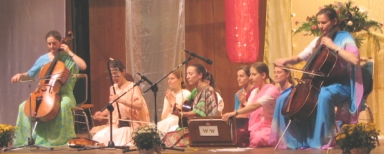
On Wednesday 3 October, Sri Chinmoy held a meditation function for his students at which many of the musical groups which usually play on Wednesdays performed. This was his first meditation function with his New York students since he returned from playing musical concerts in St. Petersburg, although he had been having walking meditations where students would arrive at his house and walk past in a loop whilst he meditated on them. During the function, Sri Chinmoy related many amusing incidents from his Russian trip.
On Friday, a meditation function was held where members of the general public were also invited to come along. Students that had been on Sri Chinmoy’s path for over 30 years were invited to come up and recite a short prayer or poem.
Another walking meditation took place on Saturday afternoon, and then a meditation function on Saturday night. Most of the Saturday night meditation function was taken up by improvised pieces of spiritual theatre. A heart-warmingly funny play was performed by the theatre troupe led by Databir Watters and Abakash Konopiaty – consisting of incidents in the life of Databir! Databir is well known in the centre for being dynamism, enthusiasm and sweetness incarnate – he is in his sixties now, but is still the driving force behind the daily games of frisbee that a group of New York students have every day after their morning meditation. (Read Ashrita Furman’s blog to find out what happened when someone tried to steal his wallet during a visit to Russia three years ago) Sri Chinmoy thought that this play was marvelous. Also that night, there was a play based on a story from the Mahabharata by Udar Robinson’s group – a year earlier, Sri Chinmoy had given them the name “Udar: the Unbounded Troupe”.
On Sunday, there was another walking meditation, and Sri Chinmoy also spoke at length on the importance of valuing the outer guidance of a meditation teacher.
On Tuesday 9 October, Sri Chinmoy hosted his last distinguished guest – Alan Nazareth, a retired Indian ambassador who had served his country in many different locations around the world, including the United States. Upon his arrival in the West in 1964, Sri Chinmoy worked in the Indian Consulate in New York for three years, before embarking full-time upon his life’s service to humanity. The Ambassador was Sri Chinmoy’s boss for a very short time in 1967 before he left, and in the ensuing years he came to quite a few of Sri Chinmoy’s concerts and other activities. Alan Nazareth is currently managing trustee of the Sarvodaya International Trust which works to uphold and spread the ideals espoused by Mahatma Gandhi, and he writes and lectures extensively on applying Gandhian ideals to the modern world. During his visit, he and Sri Chinmoy discussed the life’s work of Mahatma Gandhi, and Sri Chinmoy then presented his guest with an award honouring his years of service for his native country and for the world.
Sri Chinmoy’s creative output continued right up until the day before his passing – he composed several new songs on Wednesday.
Wednesday night was the last meditation function that Sri Chinmoy held with his students. He spoke quite a lot during the function, wondering aloud about the outcome of the Nobel Prize that was to be announced in a couple of days and casting some humorous observations on the relationship between the two words ‘peace’ and ‘harmony’. At that function, the poetry book My Christmas-New Year-Vacation-Aspiration-Prayers, part 52 was made available for sale, consisting of 91 prayer-poems Sri Chinmoy wrote during his stay in Langkawi, Malaysia in early 2006. The ninety-first poem in this book, and the last poem published during Sri Chinmoy’s lifetime, has now attained an immortal status:
“My physical death
Is not the end of my life –
I am an eternal journey.â€
One person who was present at the meditation function recalls Sri Chinmoy holding this book of poetry and wondering aloud “Will it ever end?”. We know know that was indeed a rhetorical question, for with Sri Chinmoy’s passing from this earthly plane, something has been set in motion which will propagate onwards into Eternity.
Photo by: Jowan Gauthier, Sri Chinmoy Centre Galleries – (of Sri Chinmoy in St Petersburg)


 Recently, Sri Chinmoy was in the beautiful city of St Petersburg, and as ever he managed to fit a whirlwind of activities into one short trip. Among the highlights of the trip was a concert of meditative music he gave for the general public, in which he invited his friend Purushottama Boris Grebenshikov, the Russian music legend to play a couple of songs. Purushottama combines music inspired by cultures all around the globe with exquisitely poetical lyrics reflecting on life and its true meaning, and was recently seen in New York playing a
Recently, Sri Chinmoy was in the beautiful city of St Petersburg, and as ever he managed to fit a whirlwind of activities into one short trip. Among the highlights of the trip was a concert of meditative music he gave for the general public, in which he invited his friend Purushottama Boris Grebenshikov, the Russian music legend to play a couple of songs. Purushottama combines music inspired by cultures all around the globe with exquisitely poetical lyrics reflecting on life and its true meaning, and was recently seen in New York playing a 